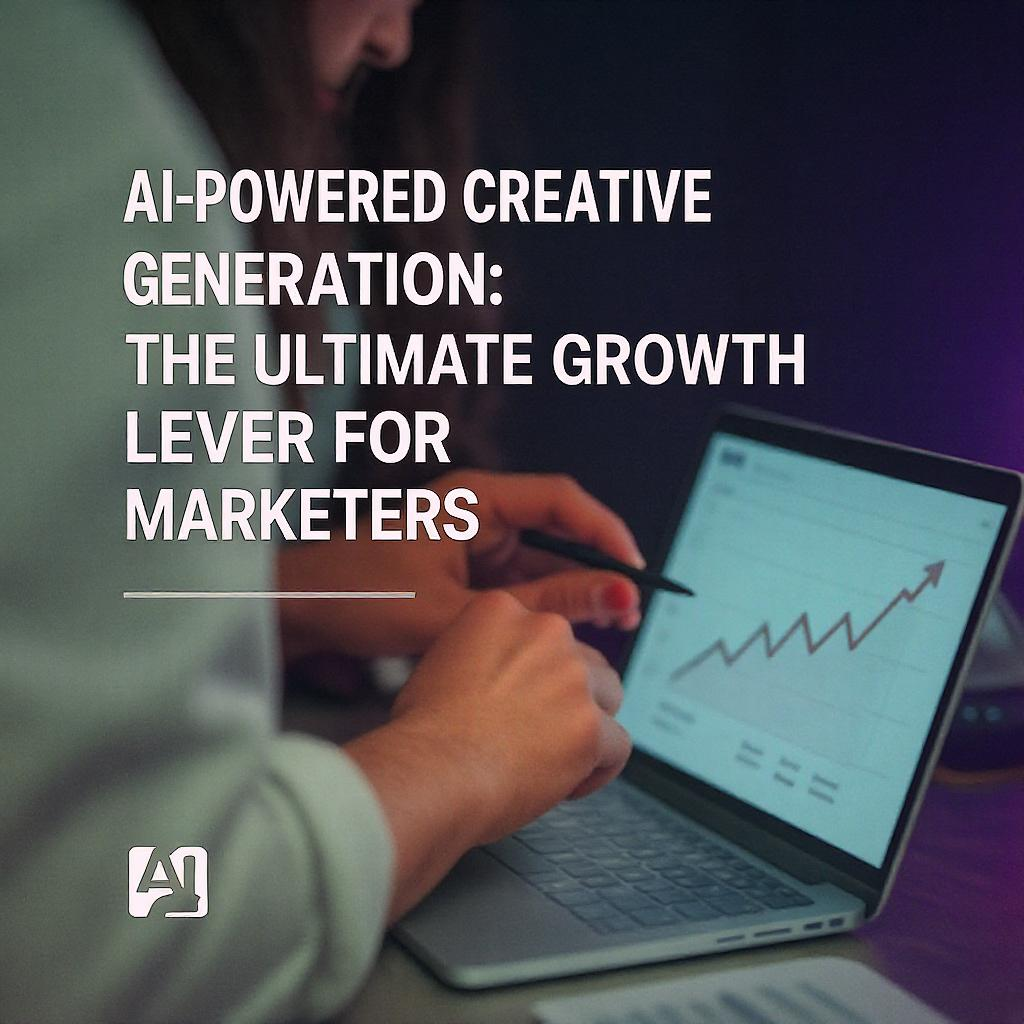AI‑Powered Creative Generation: The Ultimate Growth Lever for Marketers

1. Why Creative Bottlenecks Are a Competitive Risk
Creative production isn't keeping up with the demands of modern performance marketing. Between multi-platform distribution, personalization needs, and testing cycles, most growth teams simply don’t have the bandwidth to produce the volume—or variety—of creative required.
Whether you're managing 10 ad sets on Meta, 6 Google Display campaigns, or multiple LinkedIn A/B tests, there's a clear pattern: marketers are outpacing their creative capacity.
According to a 2022 Forrester report, 70% of marketers say content production is their top barrier to personalization. And as campaign velocity increases, bottlenecks are becoming performance liabilities.
2. The Current Creative Workflow Is Breaking
Traditional workflows—where creative requests go from growth to design to review—aren’t built for today’s speed. Common symptoms:
- Design backlog delays go-to-market timelines
- Creative fatigue lowers CTR and ROAS
- Inconsistent messaging across channels erodes brand equity
In many teams, campaign ideas get shelved—not because they weren’t good, but because there was no one available to build the assets.
The situation is forcing growth marketers to ask: How can we scale creative output without adding headcount—or compromising brand?
3. What AI Creative Generation Actually Does (and Doesn’t)
AI-powered creative platforms don’t replace creativity. They accelerate production. Here’s how leading teams use them:
- Brand Encoding: Platforms like SurgeGrowth help train AI with your fonts, colors, messaging, and visual rules.
- Creative Variation at Scale: Instead of manually producing 20 ad variations, AI tools can generate hundreds aligned to campaign goals.
- Editable Output: Teams maintain full control. Assets are drafts, not final—you edit as needed.
- Performance Feedback Loop: High-performing creatives are flagged and used to inform future variations.
AI doesn’t eliminate human input. But it does remove the bottlenecks between idea and execution—especially for repetitive, format-driven work.
4. When AI Creative Tools Don’t Work
AI-powered generation isn’t a universal solution. There are limits:
- Brand-New Brands: Without prior brand materials, AI may generate inconsistent results.
- High-Stakes Creative (e.g. TV spots, hero brand films): These still require human-first thinking and emotion-driven storytelling.
- Unclear Strategy: If campaign goals, target personas, or messaging aren’t defined, AI will only accelerate confusion.
Our experience shows that AI performs best when it complements a clear creative strategy—not substitutes for one.
5. How to Know If Your Team Is Ready
Run this short readiness check:
- Do you frequently delay campaign launches due to creative dependencies?
- Are most of your ads format-driven (display, social, email, etc.)?
- Do you have clearly documented brand guidelines?
- Are you testing multiple messages/offers but limited by production?
- Is design bandwidth a consistent bottleneck?
If you answered yes to 3 or more, AI-powered creative support is worth exploring.
6. Implementation Roadmap
Here’s a phased approach we’ve seen work:
Phase 1 – Centralize Brand Guidelines (Week 1–2)Document tone, colors, layout rules, messaging do’s and don’ts. Upload to your platform.
Phase 2 – Pilot with Existing Campaign (Week 2–4)Pick a known campaign (e.g. a retargeting funnel) and generate creative variants using AI. Benchmark results.
Phase 3 – Expand to Multi-Channel (Week 4–6)Use the platform to output for Meta, LinkedIn, Google, and email simultaneously.
Phase 4 – Feedback Loop (Ongoing)Track which creatives perform best and refine your input and messaging templates over time.
7. Evaluating AI Creative Tools: What to Look For
Look for tools that fit into your process—not the other way around.
8. Sample ROI Calculation for AI Creative Investment
If you currently spend $5,000/month on creative labor and produce ~100 assets, that’s $50 per asset. If an AI platform brings that down to $5–$10 per asset and boosts CTR by even 15%, your payback period is likely under 2 months.
Actual ROI depends on campaign scale, creative volume, and testing velocity—but cost/time savings are typically tangible in the first 6 weeks.
9. Role-Specific Recommendations
For Growth Marketers:
- Use AI to accelerate testing velocity and reduce performance plateaus
- Free yourself from creative wait cycles and launch faster
For Brand Managers:
- Maintain oversight via brand templates and human editing layers
- Ensure consistency while empowering execution teams
For Designers:
- Shift focus to high-impact projects; let AI handle repetitive output
- Set rules and visual boundaries that scale
For Agencies:
- Scale deliverables for clients without scaling headcount
- Offer AI-assisted creative testing packages as a value-add
10. Where This Is All Heading
AI’s role in creative production will continue expanding, but not as a replacement—it’s a multiplier. Expect to see:
- Real-Time Creative Adaptation: Adjustments based on live performance data
- Hyper-Personalization: Creatives generated at the audience or even individual level
- Creative Strategy Platforms: Where messaging, design, and data converge in one workflow
The future isn’t human or AI—it’s human with AI.
Citations
- https://www.mckinsey.com/capabilities/growth-marketing-and-sales/our-insights/the-value-of-getting-personalization-right-or-wrong-is-multiplying
- https://www.gartner.com/en/marketing/research/marketing-technology-survey-2020
- https://www.forrester.com/report/The-State-Of-Marketing-Creative-And-Content-Operations-2022
- https://www.bcg.com/publications/2021/how-to-improve-marketing-efficiency
- https://www.marketingaiinstitute.com/blog/ai-in-marketing-statistics
FAQs
Q: Is AI creative generation replacing design teams?
A: No. It removes repetitive, low-impact tasks—freeing up designers for strategic, high-impact work.
Q: Can it handle our brand’s complexity?
A: Only if you have strong inputs—brand DNA, campaign goals, messaging hierarchy. AI is only as good as its training.
Q: How do we measure success?
A: Start by benchmarking your current cost per creative, then track creative testing volume and ROAS improvements.
Q: What’s the best way to get started?
A: Start small. Pick a known campaign, generate variants, measure impact, and expand from there.
